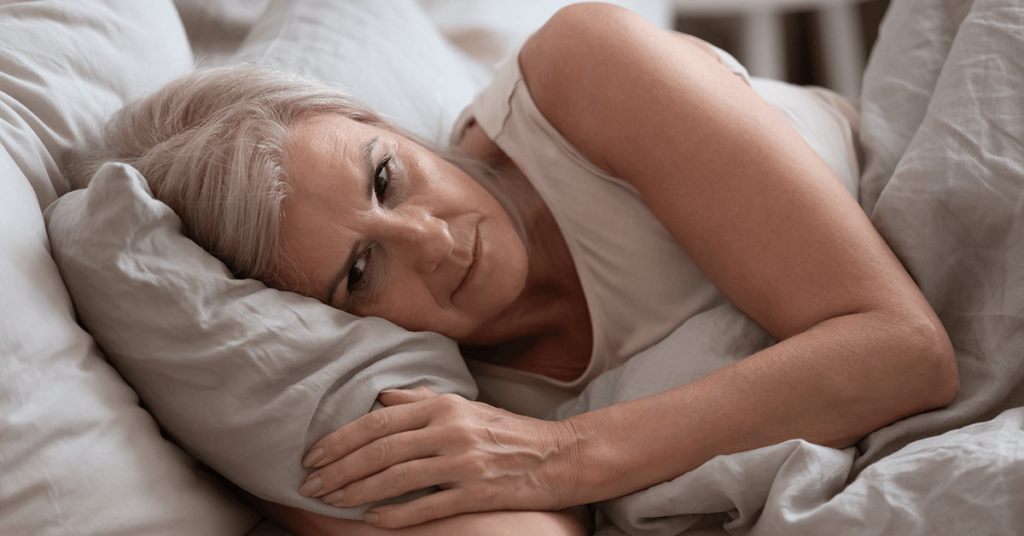
Medically reviewed by
Dacelin St Martin, MD
Triple board-certified in Sleep Medicine,
Internal Medicine, and Pediatrics.
What is ASWPD? | Causes | Clinical Presentation | Risk Factors | Diagnosis | Treatment
Overview
Sleep is vital for the proper functioning of the body. It’s the time your body gets to shut off after a long day and recharge while it gets ready for the next day.
However, there are times when this pattern becomes disrupted and affects the overall functioning of the body. It’s the inability to fall asleep at night for some people, while for others, it is falling asleep early only to wake up in the middle of the night and stay awake for the rest of the night.
This sleep disorder may arise from stress or advanced age and can be classified as an advanced sleep-wake phase disorder (ASWPD), one of the six recognized circadian sleep rhythm disorders involving sleep-wake cycles out of touch with one’s environment.
What is ASWPD?
Advanced sleep-wake phase disorder may be described as a circadian sleep disorder, which is characterized by satisfactory sleep quality and regular sleep duration, albeit with confoundingly earlier sleep and wake times. [1]
It involves an earlier sleep onset that occurs later concerning the internal circadian clock and an early wake time that results in insufficient sleep duration.[2] Sometimes, people adjust their routines to this sleep schedule.
Causes
1) Environmental Factors
Environmental conditions can induce ASWPD in a person. The relevant conditions in this context are the climatic conditions prevalent at the time of one’s birth and neurodevelopment.[1]
Studies of the association between circadian phase preference and season of birth indicate a stronger tendency for early waking among individuals born in autumn and winter than among individuals born in spring and summer.[3]
2) Genetic Factors
Genetic factors contribute to ASWPD in a person. Simply put, traits in one or more family members can be traced as contributing factors for this condition in another member of the same family. The term used to describe this occurrence in multiple biologically related family members is the familial advanced sleep phase (FASP).[4]
3) Age Factor
While data on the correlation between age and advanced sleep phase disorder is quite limited, it is a condition that appears to get worse with age.[5]
The condition is more common among the elderly, whose natural response to light diminishes as they grow older. Changes in responsiveness to light due to cataracts are also likely to contribute to advanced sleep-wake disorder in older patients.[6]
Clinical Presentation
This condition should be isolated from related sleeping disorders. As earlier stated, excessive sleepiness in the evening and chronic early morning awakening are the defining clinical features of ASWPD.[1]
People who come down with this condition typically feel the strong urge to go to bed as early as late in the afternoon—coupled with consistent waking before sunrise. While this change might be relatively easy for some patients to adapt to, a person’s lifestyle and daily schedule are adversely affected.
Resistance on the part of patients resulted in sleep deficits and increased drowsiness, which exacerbates the condition; however, some patients succumb to the evening pull without having their normal functioning impaired.
Risk Factors
Contrary to fears that may be harbored by people who may read excess meaning to minor sleep challenges, ASWPD is not common. Older adults are the most vulnerable due to lingering conditions that could worsen the disorder, and the condition is made manifest in only one percent of the population.
Diagnosis
Before concluding that a person suffers from ASWPD, a diagnosis must first be made. These are some tools that help with a diagnosis:
1) Sleep Diary
This diagnostic tool uses a table of questions that seek to assess the timing and quality of one’s sleep over a week or two.
2) Actigraphy
Actigraphy uses a wristwatch-like device to monitor one’s active periods and one’s periods of rest over days or weeks.
3) Melatonin Sampling
Melatonin sampling involves testing one’s blood or saliva samples to assess the amount of melatonin produced by a person.
4) Core Body Temperature Measurements
Here, the temperature of one’s internal organs is measured predominantly by the insertion of a thermometer into one’s rectum or the use of infrared sensors in the tympanic membrane of a person’s ear.
Treatment vs Other Options
The condition’s primary treatment option is bright light therapy, which is to be carried out during the evening. It aims to push the circadian as far back as possible to realign it with the environmental light-dark cycle and the regular social cycle.[1]
The idea behind bright light therapy is grounded in human phase-response curves to light.[7] These curves indicate that bright light in the evening and in early in the night would elicit a delay that would bring back a person in conformity with the regular circadian rhythm.
Some physicians may recommend that their patients establish a strenuous evening exercise regimen.
Conclusion
While ASWPD should not create much worry for people diagnosed with it, treatment tends to take time. Thus, patients are encouraged to strike a balance between medical treatment and less conventional options—with medical treatment the more ideal recovery route.
References:
- Sharkey, M.K. (2020, April 7). Advanced sleep wake disorder. Retrieved from <https://www.uptodate.com/contents/advanced-sleep-wake-phase-disorder?source=autocomplete&index=1~3&search=advanced%20s#H3814572907>
- During, E.H; Kushida, C.A (2020). Clinical Sleep Medicine: A Comprehensive Guide for Mental Health and Other Medical Professionals. Washington, DC, United States: American Psychiatric Association Publishing
<https://books.google.com.ng/books/about/Clinical_Sleep_Medicine.html?id=M5n6DwAAQBAJ&source=kp_book_description&redir_esc=y> - Natale, V., & Adan, A. (1999). Season of birth modulates morningness-eveningness preference in humans. Neuroscience letters, 274(2), 139–141
<https://www.sciencedirect.com/science/article/abs/pii/S0304394099006722?via%3Dihub> - Jones, C. R., Campbell, S. S., Zone, S. E., Cooper, F., DeSano, A., Murphy, P. J., Jones, B., Czajkowski, L., & Ptácek, L. J. (1999). Familial advanced sleep-phase syndrome: A short-period circadian rhythm variant in humans. Nature medicine, 5(9), 1062–1065 <https://www.nature.com/articles/nm0999_1062>
- Crowley, S.K; Youngstedt, S.D. (2013) Pathophysiology, Associations, and Consequences of Circadian Rhythm Sleep Disorder. Encyclopedia of Sleep (1st ed., pp. 16-21)
<https://www.sciencedirect.com/science/article/pii/B9780123786104002667> - Yan, S. S., & Wang, W. (2016). The effect of lens aging and cataract surgery on circadian rhythm. International journal of ophthalmology, 9(7), 1066–1074
<https://www.ncbi.nlm.nih.gov/pmc/articles/PMC4951664/> - Khalsa, S. B., Jewett, M. E., Cajochen, C., & Czeisler, C. A. (2003). A phase response curve to single bright light pulses in human subjects. The Journal of physiology, 549(Pt 3), 945–952<https://www.ncbi.nlm.nih.gov/pmc/articles/PMC2342968/>

